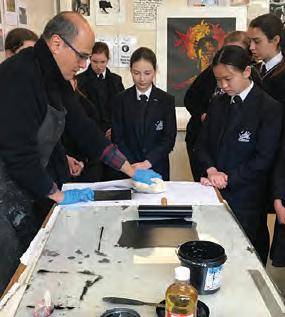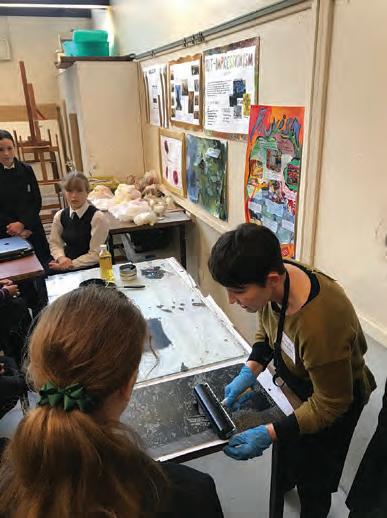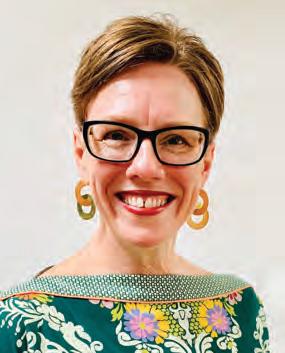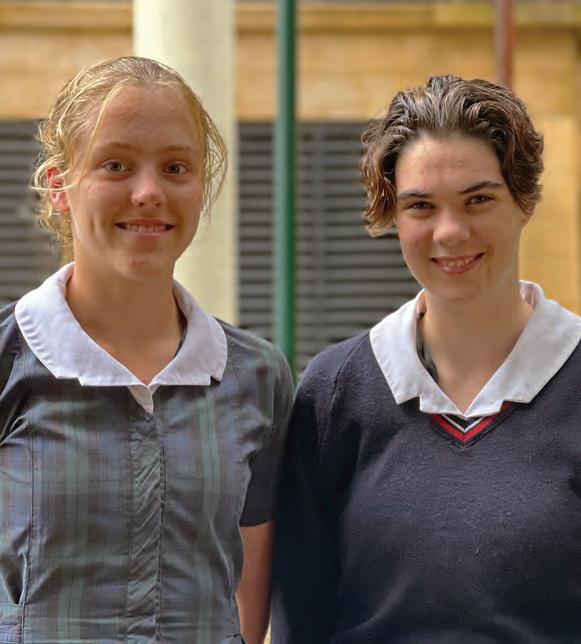
8 minute read
Haptic thinking in the Visual Arts classroom

THE ROLE OF DRAWING AND SKETCHING IN CREATIVE THINKING
To contextualise the process of developing ideas by sketching in the visual arts diary, reference can be made to the contemporary Finnish architect and writer Juhani Pallasmaa. Pallasmaa is well-known for his writing about the relationship between the hand and the mind and how drawing is a tool for creative thinking.
In his book, The Thinking Hand (2009), Pallasmaa refers to a cognitive loop that emerges in the act of drawing. Through the process of visualising ideas in drawing form, marks made by hand-held pencil on paper are seen by the eyes and the mind responds intuitively through movement of the hand. As the hand drawn image forms on paper, the idea imagined in the brain is reformed. In this cyclical way, a student’s initial sketch made in the visual arts diary maps the emerging idea for a work in progress which has yet to be resolved in concrete form.
LEARNING THROUGH PRINTMAKING

Learning through artmaking in Visual Arts is dependent on the fusion of cognitive and manual skills. Thinking is intertwined with haptic experiences of tactile and sensory engagement with matter. The images produced by students through bodily engagement with materials and hand tools represent thinking made concrete by the hand. At the heart of printmaking lies the complex relationship between hand and mind. The artists in residence gave the students insightful practical demonstrations and, in collaboration with the classroom teacher, supported each student’s experimentation with media, tools and techniques. This process was critical in informing students with an understanding of the material properties of linocut and drypoint printmaking for students to effectively develop designs for two different printmaking forms.
“The hand grasps the physicality and materiality of thought and turns it into a concrete image.” - Juhani Pallasmaa
Top left: Rafael Butron showing students examples of intaglio printmaking Top right: Rafael demonstrating the inking process for drypoint printing Bottom image: Anne Starling with Year 8 students sketching their preliminary ideas in the Visual Arts process diary
PRINTMAKING AS A TOOL FOR CREATIVE THINKING
Having developed and refined their two designs through multiple iterations of preliminary sketches, students commenced the process of executing their drawings in linocut and drypoint media using hand-held lino cutting and etching tools.
The cutting tool in the hand of the student becomes a medium through which the cognitive loop of imagination and image play out in the creative process of doing things with materials. The enjoyment that comes with learning new skills in the use of hand tools and exploring the properties of materials encourages absolute concentration on the task. When this focus leads to abandoning conscious control for a more intuitive approach, conditions for creativity are supported. Under the watchful guidance of the artists in residence and teachers, students were encouraged to seize the potential in a mark, texture, shape or idea that was not planned or expected. In this way, the art classroom is like a laboratory of play where conditions for serendipity are cultivated by the art teacher and where students find excitement in the uncertainty that comes with engaging with materials, tools and techniques. This process affords the student opportunities to see value in unexpected outcomes as a result of experimentation, risk taking and mistake making. By promoting curiosity and an open mind, students learn to make connections between things that would otherwise be considered as unconnected; they learn to become receptive to alternative ways of seeing and experiencing the world, and gain confidence in resolving challenges for which they have no preconceived solution. Whilst haptic ways of thinking through doing and making are increasingly less valued in contemporary society, a more open-minded view of how different ways of thinking can be nurtured to best support the intellectual and wellbeing needs of our students is in all our best interests. To quote Roger Kneebone, Professor of Surgical Education and Engagement Science at Imperial College London, “doing and thinking are two sides of the same coin”.



Left: The Shrivelling Future by Lucinda Wlossak, Year 8 2020, drypoint print
Below: Honey Extinction by Bella Jones, Year 8 2020, drypoint print with linocut collage

The Disguise by Abigail Barfield, Year 8 2020, linocut print

STUDENT PERSPECTIVES
“The Artist in Residence experience was very beneficial to my creative wellbeing as I noticed that throughout the weeks, my creative side came out and I was able to put those skills that I didn’t know I had to the test. It really pushed me to think outside the box and resulted in a final product that I was very happy with.” - Yvette Volk, Year 8
“I really liked the fact that we got to do artworks with the artists and learn new skills when making artworks by hand. I liked the new artwork skills that we did. The lino was fun to learn to carve things. I definitely think that making these new artworks by hand should be used a lot more often. This is because we all did learn something new while having fun!” - Lucy Pennington, Year 8 “The Artist in Residence program was really inspiring, and interesting to watch and learn how exactly they created their artworks. They seemed to really engage with the students, and it was very helpful having a professional teach and show you each step of the process of making either the lino or etching.” - Grace Connell, Year 8
“While the artists in residence were here, I felt as though my work in art was much better and I worked harder to get better results. I really enjoyed what we did throughout the process and I felt like the artists enjoyed being here too.” - Mackenzie Burke, Year 8
Bibliography Dewey, J. (2005). Art as experience, United States: Penguin Books. Danilowitz, B., Horowitz, F.A. and Albers, J. (2006). Josef Albers: To open eyes – at the Bauhaus, Black Mountain College and Yale, United Kingdom: Phaidon Press. Jones, C. (2018). Let’s get physical: Supporting arts based research through haptic learning, Art Libraries Journal, Vol 43, 3, 149-152. DOI: https://doi.org/10.1017/ alj.2018.20 Kneebone, R. (2017). Medicine: Discovery through doing. Nature, 542, 294. DOI: https://doi.org/10.1038/542294a Leski, K. (2015). The Storm of Creativity, United States: MIT Press.Petherbridge, D. (2010). The primacy of drawing: Histories and theories of practice. Norway: Yale University Press. Pallasmaa, J. (2009). The thinking hand, John Wiley and Sons, 2009; Pallasmaa, J. (2011). The embodied image, John Wiley and Sons.
What is an academic journal?
A discussion with Associate Professor Nicole Mockler
BY LUCY CLARK AND CHARLOTTE HARTIN, YEAR 10
Year 10 students Lucy Clark and Charlotte Hartin were inspired to find out more about the world of academic journal articles following their Sokratis project investigations in 2020. Lucy and Charlotte interviewed Dr Nicole Mockler through a series of email conversations in 2020 and the beginning of 2021.
WHAT IS A JOURNAL?
An academic journal provides access to reliable research articles. The articles have been curated and selected by the editor, following a peer-review process by fellow academics. This process of selection means that only journal specific articles are published.
Journals are a form of presentation facilitating the discussion of research. There is a tiered system amongst academic journals, due to the hierarchy within the academic world. The highertiered journals are significantly more selective with the articles they publish, creating levels of prestige. Academic journals are vital as they enable researchers to share their opinions, whilst challenging those of others.
Unfortunately, many people struggle to access or interpret scholarly articles. This is due to the elite nature of the academic community. To delve into this world of information and pressing opinions, we must educate people in the skills of analysis, interpretation and application of the research presented and encourage the use of academic journals as valuable resources to our learning development.

INTRODUCTION
Dr Nicole Mockler is an Associate Professor at the Sydney School of Education and Social Work, within the University of Sydney. She is also known for her work as the editor of the journal, The Australian Educational Researcher. Dr Mockler’s interest areas include education policy, pedagogy and continuing professional development for teachers - enabling them to support their students through curriculum development and thorough research to provide reliable information regarding the enhancement of educational strategies. Dr Mockler has worked in education for more than 25 years, beginning as a classroom teacher, providing valuable input as an education consultant, and eventually as a teacher educator and educational researcher.

Lucy Clark and Charlotte Hartin
Q&A
Professor Mockler, why were you interested in becoming involved in academia?
In the last three years before I left teaching, I was in a school leadership role leading teacher professional learning. I became very interested in how good teacher learning could support teachers to best support the learning of their students. I began working part time on my PhD at the University of Sydney and was investigating how teachers’ professional identity is formed and the role of professional learning in that.
After three years of working very, very part time on the PhD, I decided to leave teaching so that I could concentrate on getting it finished. I ended up taking a few more years to complete the PhD after that as I set up an education consultancy focused on helping schools to support teacher learning, and working across independent, Catholic and public schools, as well as with some of the systems such as the Association of Independent Schools, the Department of Education and the Catholic Schools Office of Broken Bay. After finishing my PhD, I decided to move into academia full time, and spent six years as a Lecturer and then Senior Lecturer in the School of Education at the University of Newcastle. I moved to take up my current role at the University of Sydney in 2015.










